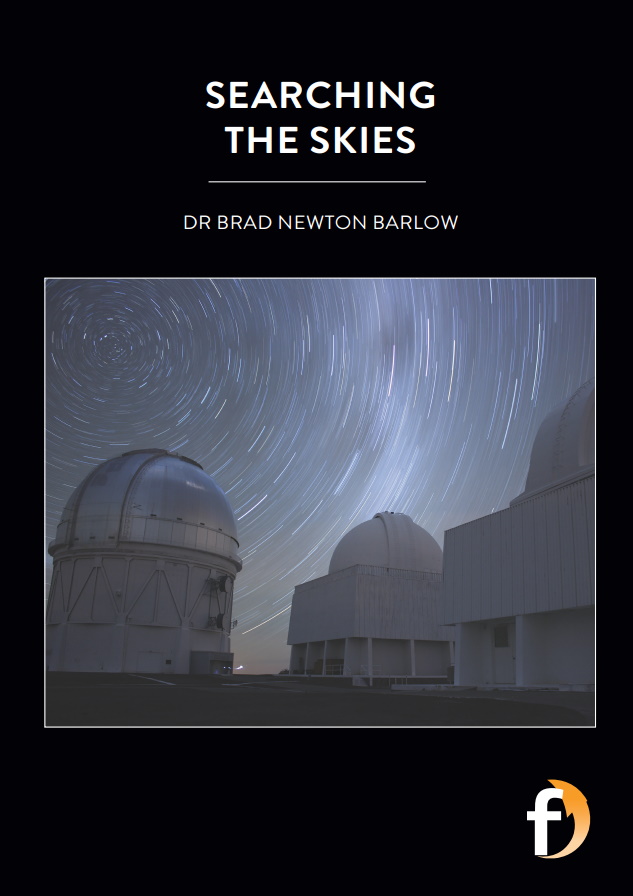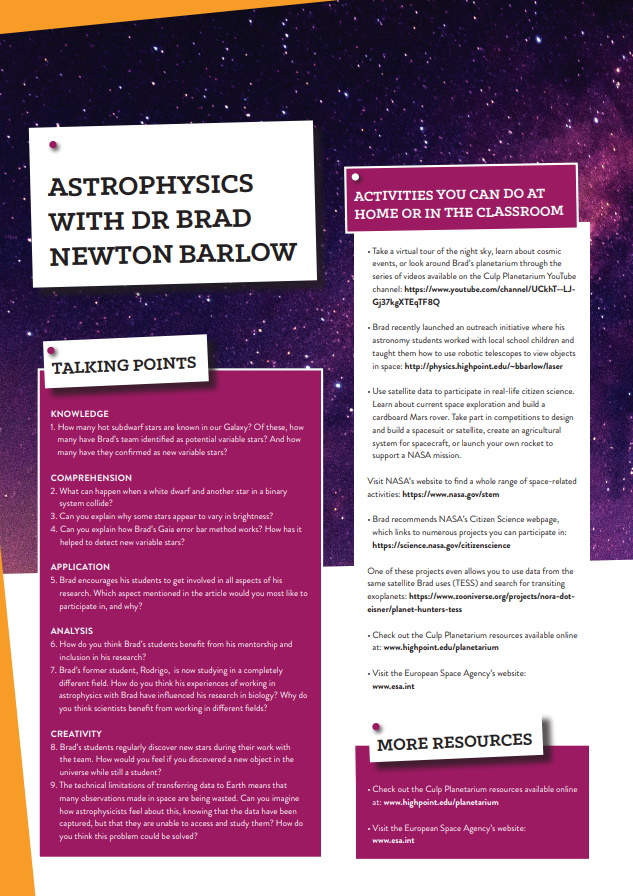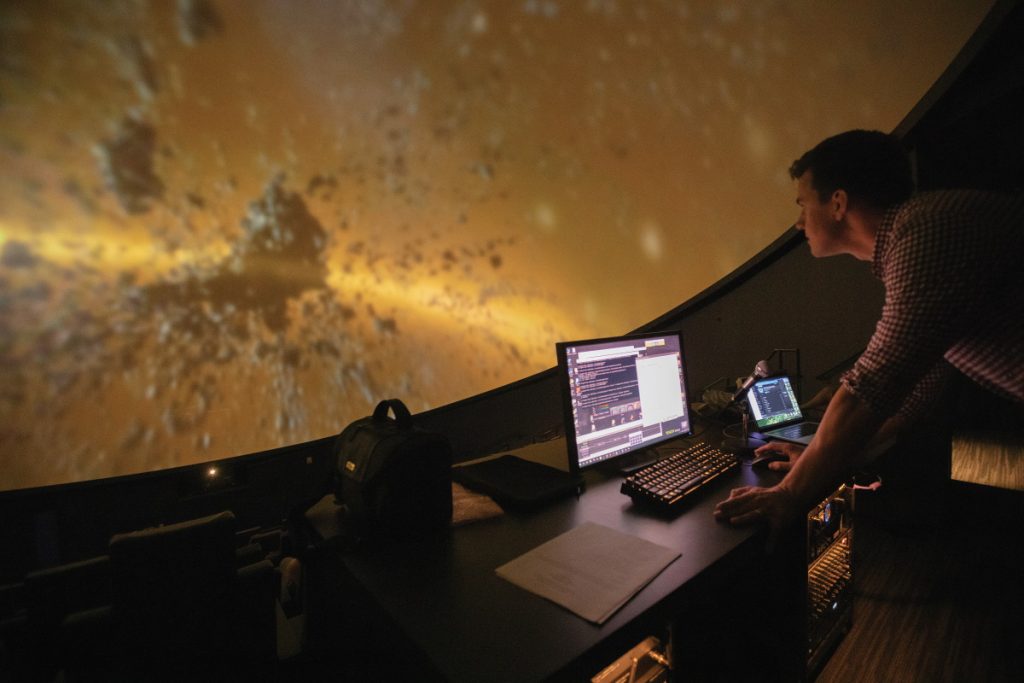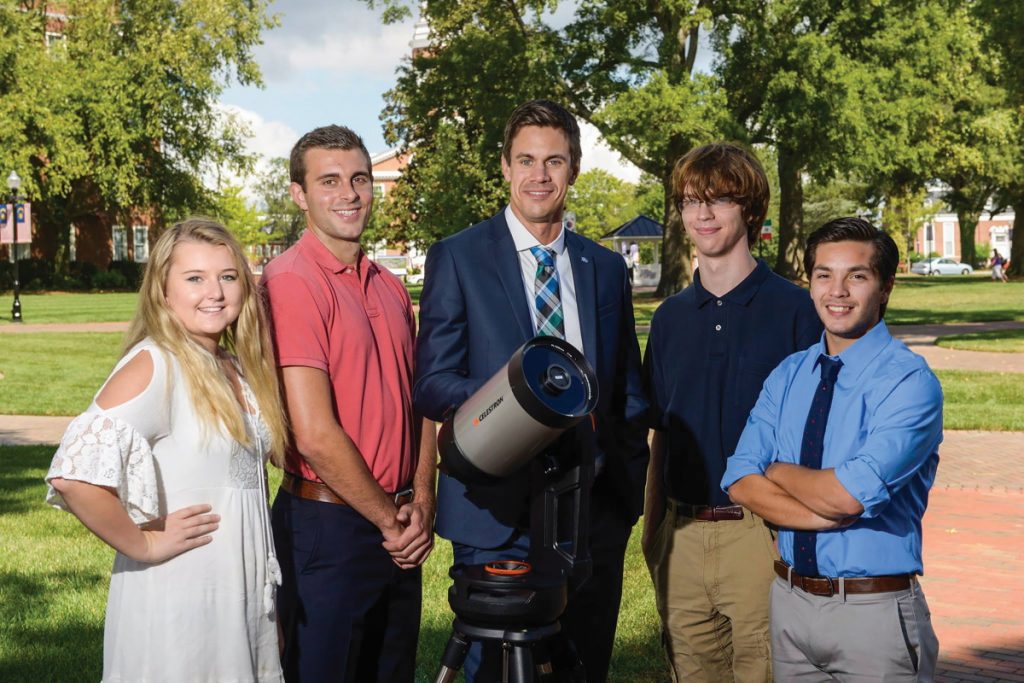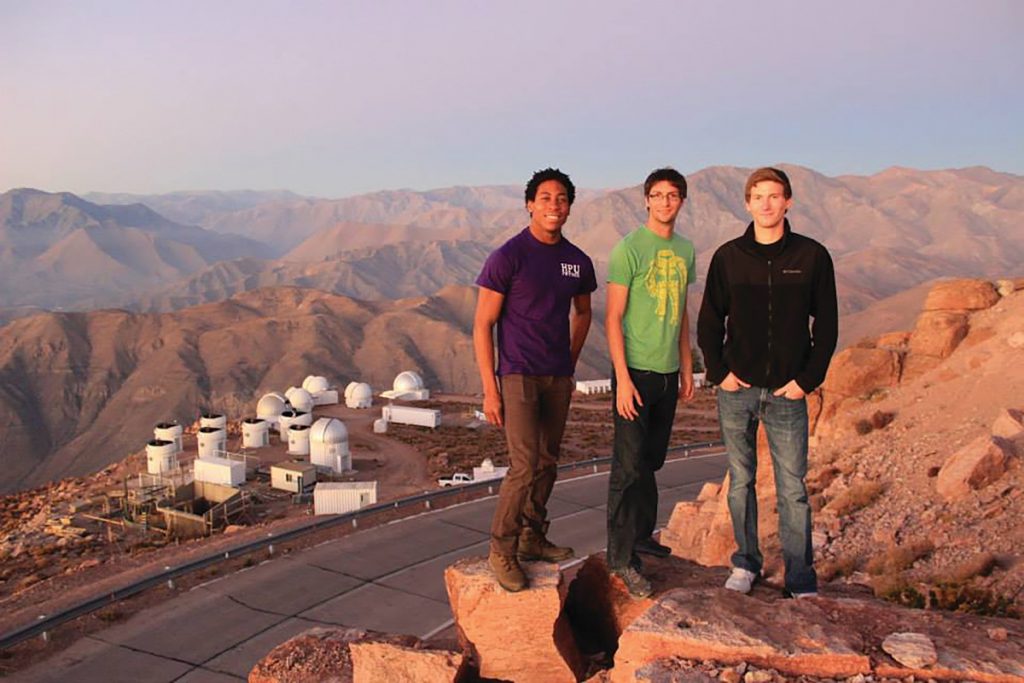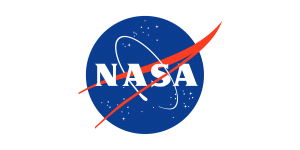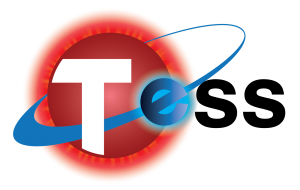Searching the skies
The Universe is filled with one billion trillion stars – look at the sky on a clear night and the few thousand that are visible are incredible to see. The fascination of gazing into the vastness of the Universe has led Dr Brad Newton Barlow, of the Culp Planetarium and High Point University in the US, to delve deeper into space to hunt for a strange type of star called a hot subdwarf
TALK LIKE AN ASTROPHYSICIST
ASTRONOMY – the study of the Universe
ASTROPHYSICS – a branch of astronomy which studies the physical processes and properties of the Universe
BINARY STAR SYSTEM – two stars which orbit each other
COSMOLOGY – a branch of astronomy which studies the origin and evolution of the Universe
PYTHON – a scripting language used in computer coding
RED GIANT – a star that has expanded to a tremendous diameter during the final stages of its lifetime
TYPE 1A SUPERNOVA – the explosion of a white dwarf upon exceeding its mass limit
VARIABLE STAR – a star whose brightness changes as we view it from Earth
WHITE DWARF – the extremely dense, Earth-sized remnant core of a dead star
The Universe is full of strange and wonderous things! Amongst the rarities that intrigue astrophysicists are hot subdwarfs – very hot, dense stars. Researchers think they form from red giants stripped of their outermost atmosphere by gravitational interactions with another nearby star. Consistent with this theory, almost all hot subdwarfs are found in binary systems, existing in orbit with another star. As Dr Brad Newton Barlow, Director of the Culp Planetarium and Associate Professor of Astrophysics at High Point University in the US, explains, “Hot subdwarfs are definitely not a ‘normal’ type of star.”
STARS COLLIDING
Some hot subdwarfs have a hot binary companion such as a white dwarf. If a hot subdwarf merges with its neighbouring white dwarf, it may explode to form a Type 1a supernova. Cosmologists use these supernovae to measure vast distances across the Universe and have shown that the expansion of the Universe is accelerating. We frequently observe Type 1a supernovae explosions in other galaxies, but astronomers have not caught a binary system just before it collides and explodes. Until now…
Brad helped discover a new binary system containing two stars so close together that they orbit each other in under two hours. “Earth takes 365 days to orbit the sun,” explains Brad, “but these two stars orbit in under two hours!” They are so close and orbiting so quickly that they are slowly spiralling in. Soon (in astrophysical terms, millions of years from now) the stars will interact. The white dwarf will explode as a Type 1a supernova, causing one of the most powerful and luminous events in the Universe.
SEARCHING FOR STARS
While few hot subdwarf stars were once known, the European Space Agency’s Gaia spacecraft recently discovered >30,000 new ones, giving a total of ~40,000 hot subdwarfs in our part of the Milky Way. Most interesting of these are the variable hot subdwarfs, whose brightness varies as we observe them from Earth.
This variation occurs if the companion star is a white dwarf, which have intense gravitational fields. This distorts the hot subdwarf from a sphere to an ellipsoidal shape. As the binary stars orbit, different sides of the ellipsoidal hot subdwarf will face Earth, causing an apparent change in the observed brightness.
This variation also occurs if the hot subdwarf has a cooler companion. As the two stars orbit, the cooler companion will block, or ‘eclipse’, some of the light from the hot subdwarf, preventing it reaching Earth, so the observed brightness will decrease.
The traditional method of observing variable stars involves pointing an Earth-based telescope at the star for several hours and recording a series of images. The brightness of the star in each image is plotted against time to produce a “light curve”, allowing variations in brightness to be quantified.
With 40,000 hot subdwarfs, it would take far too long to study them all this way. Moreover, most of this expensive telescope time would be wasted, as most hot subdwarfs are not variable. Brad, along with his students and collaborators, devised a new method to ascertain which stars they should focus investigations on.
THE GAIA ERROR BAR METHOD
Brad and the team realised that when the Gaia spacecraft records a star’s brightness, the associated error can indicate whether the star is variable. “Take two stars with the same brightness – one that is constant in time, another that changes in brightness,” explains Brad. “The scatter in Gaia’s brightness measurements will be larger for the variable star, because it has a different brightness each time Gaia observes it.” This means that without a light curve, requiring hours of telescope observations, Brad can now identify potential variable stars just from the anomalously high error bars on their brightness measurements.
This novel method is highly efficient, with a >95% success rate. From the 40,000 known hot subdwarfs, Brad’s team have identified 2000 stars that are potentially variable, and therefore of most interest for investigation. It would still take too long to study all these individually with Earth-based telescopes looking at small regions of the sky. Instead, astrophysicists need survey-oriented systems with large fields-of-view to acquire follow-up observations of numerous stars at the same time.
NASA’s TESS satellite was launched in 2018 to search for exoplanets, but the data it gathers can also be useful for those who want to examine the light curves of stars. TESS spends 27 days pointing at a sector of the sky, collecting a sequence of ~20,000 images. Once complete, it points to a new sector and collects images for another 27 days. This process will be repeated for several years, until the entire sky has been imaged.
LIMITED BANDWIDTH
Even though TESS is imaging all the stars it sees, many of these observations are ‘wasted’ because there simply is not enough bandwidth available to downlink all the data back to Earth.
Astronomers who want to access these observations must compete against each other, making a case for why the data they are interested in deserves to be sent to Earth. Brad’s team is fortunate to have had two cases accepted. These are providing them with 10 million individual brightness measurements from TESS, allowing them to generate light curves for several thousand hot subdwarf stars.
RUNNING CODE
Once data have been downlinked to Earth, Brad and his team process and analyse them using computer code they wrote in Python, looking for any periodic signals in the stars’ light curves. They classify new variable stars by running code to examine the shape of the light curve, then more codes help to determine important parameters such as the masses and radii of the stars in the binary system.
Reference
https://doi.org/10.33424/FUTURUM139
TALK LIKE AN ASTROPHYSICIST
ASTRONOMY – the study of the Universe
ASTROPHYSICS – a branch of astronomy which studies the physical processes and properties of the Universe
BINARY STAR SYSTEM – two stars which orbit each other
COSMOLOGY – a branch of astronomy which studies the origin and evolution of the Universe
PYTHON – a scripting language used in computer coding
RED GIANT – a star that has expanded to a tremendous diameter during the final stages of its lifetime
TYPE 1A SUPERNOVA – the explosion of a white dwarf upon exceeding its mass limit
VARIABLE STAR – a star whose brightness changes as we view it from Earth
WHITE DWARF – the extremely dense, Earth-sized remnant core of a dead star
The Universe is full of strange and wonderous things! Amongst the rarities that intrigue astrophysicists are hot subdwarfs – very hot, dense stars. Researchers think they form from red giants stripped of their outermost atmosphere by gravitational interactions with another nearby star. Consistent with this theory, almost all hot subdwarfs are found in binary systems, existing in orbit with another star. As Dr Brad Newton Barlow, Director of the Culp Planetarium and Associate Professor of Astrophysics at High Point University in the US, explains, “Hot subdwarfs are definitely not a ‘normal’ type of star.”
STARS COLLIDING
Some hot subdwarfs have a hot binary companion such as a white dwarf. If a hot subdwarf merges with its neighbouring white dwarf, it may explode to form a Type 1a supernova. Cosmologists use these supernovae to measure vast distances across the Universe and have shown that the expansion of the Universe is accelerating. We frequently observe Type 1a supernovae explosions in other galaxies, but astronomers have not caught a binary system just before it collides and explodes. Until now…
Brad helped discover a new binary system containing two stars so close together that they orbit each other in under two hours. “Earth takes 365 days to orbit the sun,” explains Brad, “but these two stars orbit in under two hours!” They are so close and orbiting so quickly that they are slowly spiralling in. Soon (in astrophysical terms, millions of years from now) the stars will interact. The white dwarf will explode as a Type 1a supernova, causing one of the most powerful and luminous events in the Universe.
SEARCHING FOR STARS
While few hot subdwarf stars were once known, the European Space Agency’s Gaia spacecraft recently discovered >30,000 new ones, giving a total of ~40,000 hot subdwarfs in our part of the Milky Way. Most interesting of these are the variable hot subdwarfs, whose brightness varies as we observe them from Earth.
This variation occurs if the companion star is a white dwarf, which have intense gravitational fields. This distorts the hot subdwarf from a sphere to an ellipsoidal shape. As the binary stars orbit, different sides of the ellipsoidal hot subdwarf will face Earth, causing an apparent change in the observed brightness.
This variation also occurs if the hot subdwarf has a cooler companion. As the two stars orbit, the cooler companion will block, or ‘eclipse’, some of the light from the hot subdwarf, preventing it reaching Earth, so the observed brightness will decrease.
The traditional method of observing variable stars involves pointing an Earth-based telescope at the star for several hours and recording a series of images. The brightness of the star in each image is plotted against time to produce a “light curve”, allowing variations in brightness to be quantified.
With 40,000 hot subdwarfs, it would take far too long to study them all this way. Moreover, most of this expensive telescope time would be wasted, as most hot subdwarfs are not variable. Brad, along with his students and collaborators, devised a new method to ascertain which stars they should focus investigations on.
THE GAIA ERROR BAR METHOD
Brad and the team realised that when the Gaia spacecraft records a star’s brightness, the associated error can indicate whether the star is variable. “Take two stars with the same brightness – one that is constant in time, another that changes in brightness,” explains Brad. “The scatter in Gaia’s brightness measurements will be larger for the variable star, because it has a different brightness each time Gaia observes it.” This means that without a light curve, requiring hours of telescope observations, Brad can now identify potential variable stars just from the anomalously high error bars on their brightness measurements.
This novel method is highly efficient, with a >95% success rate. From the 40,000 known hot subdwarfs, Brad’s team have identified 2000 stars that are potentially variable, and therefore of most interest for investigation. It would still take too long to study all these individually with Earth-based telescopes looking at small regions of the sky. Instead, astrophysicists need survey-oriented systems with large fields-of-view to acquire follow-up observations of numerous stars at the same time.
NASA’s TESS satellite was launched in 2018 to search for exoplanets, but the data it gathers can also be useful for those who want to examine the light curves of stars. TESS spends 27 days pointing at a sector of the sky, collecting a sequence of ~20,000 images. Once complete, it points to a new sector and collects images for another 27 days. This process will be repeated for several years, until the entire sky has been imaged.
LIMITED BANDWIDTH
Even though TESS is imaging all the stars it sees, many of these observations are ‘wasted’ because there simply is not enough bandwidth available to downlink all the data back to Earth.
Astronomers who want to access these observations must compete against each other, making a case for why the data they are interested in deserves to be sent to Earth. Brad’s team is fortunate to have had two cases accepted. These are providing them with 10 million individual brightness measurements from TESS, allowing them to generate light curves for several thousand hot subdwarf stars.
RUNNING CODE
Once data have been downlinked to Earth, Brad and his team process and analyse them using computer code they wrote in Python, looking for any periodic signals in the stars’ light curves. They classify new variable stars by running code to examine the shape of the light curve, then more codes help to determine important parameters such as the masses and radii of the stars in the binary system.
WHAT NEXT FOR THE TEAM?
This project is generating a lot of data for Brad and his team. To date they have discovered over 100 new variable hot subdwarf stars. Some of these are hot subdwarfs in orbits with red dwarfs and white dwarfs, which will help astrophysicists understand how hot stars evolve in binary systems. Other systems turned out not to be hot subdwarf binaries at all, but strange “cataclysmic variables”, in which mass is transferring from a red dwarf to a white dwarf. Many of the new variables have yet to be classified.
The team will identify which of these systems are most interesting for further research. They will apply to visit Earth-based telescopes, where they will conduct important follow-up observations enabling them to analyse these incredible new stars.
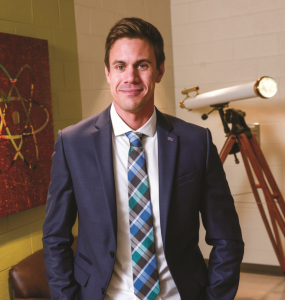 DR BRAD NEWTON BARLOW
DR BRAD NEWTON BARLOW
Director of the Culp Planetarium and Associate Professor of Astrophysics, High Point University, North Carolina, USA
FIELD OF RESEARCH: Stellar Astrophysics
RESEARCH PROJECT: Investigating hot subdwarf stars
FUNDERS: NASA and the National Science Foundation
 DR BRAD NEWTON BARLOW
DR BRAD NEWTON BARLOW
Director of the Culp Planetarium and Associate Professor of Astrophysics, High Point University, North Carolina, USA
FIELD OF RESEARCH: Stellar Astrophysics
RESEARCH PROJECT: Investigating hot subdwarf stars
FUNDER: NASA and the National Science Foundation
ABOUT ASTROPHYSICS
To study the physics of the Universe, an astrophysicist spends a lot of time writing and debugging computer code to run simulations or analyse data. “On some days this goes smoothly,” says Brad. “But I’ve spent entire days banging my head against my keyboard, trying to find one small error in my code!”
While a physicist, biologist or chemist can go into their laboratory and control their experiment, astronomers do not have such luxuries. “The Universe provides us a one-way information stream in the form of light and gravitational waves,” explains Brad. “The inability to control the experiment, or to even see what we are studying, forces us to be very careful when interpreting our results.”
“It’s fun to uncover the secrets of the Universe!” says Brad. “I enjoy the thrill that comes with making new discoveries. It makes me feel like I’m a part of something bigger than myself.”
For Brad, one of the most rewarding aspects is watching his students develop into scientists and make discoveries of their own. He has a rule for everyone who works with him: if they discover something new, they must not tell anyone else about it, including Brad, for 15 minutes. Why? “For those 15 minutes, they are the only being in the entire Universe to know that bit of information,” explains Brad.
PATHWAY FROM SCHOOL TO ASTROPHYSICIST
At school, take maths, physics and computing courses, and Brad recommends gaining experience in coding. In college/university, your courses will focus on astronomy, physics, maths and computer science. Brad advises, “No matter what stage you’re at, reach out to faculty members or astronomers to see if you can participate in the research they do.”
Many astrophysicists will have a degree in astronomy, astrophysics or space science, but a broader degree in physics, maths or geophysics can also lead to a career in astrophysics.
Don’t ever doubt your own abilities because others around you seem smarter or more confident than you are. Even the best scientists in the world make mistakes and doubt themselves from time to time.
HOW DID BRAD BECOME AN ASTROPHYSICIST?
As a child I was interested in two things: astronomy and music. I received my first telescope when I was 10 and I spent uncountable nights observing the sky with it. Around the same time, my grandparents taught me how to play the piano and I started writing my own musical compositions. I absolutely love listening to movie soundtracks (think Hans Zimmer and John Williams). Aside from being an astronomer, my dream job has always been to compose scores for movies.
When I was growing up, my dad took my brother and me outside to watch a meteor shower. To this day, I remember how the shooting stars looked like they were coming out from behind the giant oak tree in our yard. I was thought that the tree might catch on fire!
I think a combination of curiosity, creativity, patience and grit have contributed to my success as a scientist.
If I need to unwind after a long day, I immediately go to the piano and start playing and writing music. I actually keep a keyboard in my office so I can take short, creative breaks throughout the day.
When I was a graduate student, I helped write a very small piece of the control software for the Goodman spectrograph on the 4.1-m SOAR Telescope in Chile. This instrument is now used by astronomers around the world to make exciting observations and discoveries, and it makes me proud to know I played even a small role in making this possible.
STUDENT RESEARCHERS
Brad explains, “I’ve always believed that the best way to learn science is simply to do science.” His students help to write proposals for time allocations on observational telescopes, travel with him to collect telescope data, write code to process and analyse data, and present results at conferences and in journals.
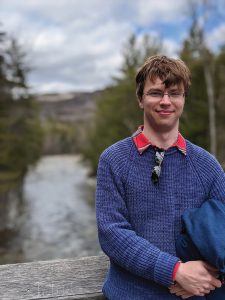
THOMAS BOUDREAUX
Astrophysics graduate student Dartmouth College, USA
I had wonderful mentors all throughout my education, but I decided to pursue science in preschool after looking at a picture book with a picture of all nine (as there were at that point) planets. I have never looked back.
My role as an undergraduate researcher with Brad evolved over time. At the start, I was analysing data for Brad. Later on, I was proposing projects and driving them while he guided the bigger picture.
How to be a good programmer was the most important hard skill that I picked up. More nebulously, I learnt how to think about and frame research questions in my head.
Having an idea that you can implement is the best feeling in the world. For me, this means programming it into a computer. It either works, or it doesn’t, but the act of taking that idea and making it into something testable is incredibly satisfying.
I fell in love with stellar physics while working with Brad, and every time I learn something new about stars my mind is blown.
I am currently working on a 50-year-old code base which models how stars live and die. The way people programmed in the 1970s was very different and that, in combination with the complexity of the code, makes it very difficult to work with.
A few years ago, I published a paper on the application of deep learning to the classification of variable stars. It wasn’t super complex in hindsight, but it was the first project I fully conceived and drove to completion. I am very proud of that.
Make a connection to a faculty member or teacher if you can. I would not be where I am today without amazing mentors from grade school, high school, college, and now graduate school.
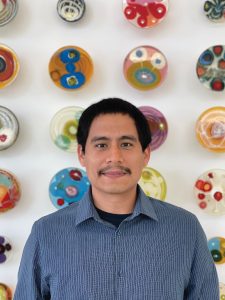
RODRIGO CATALAN-HURTADO
Biochemistry graduate student Eukaryotic Pathogens Innovation Center, Clemson University, USA
I decided to pursue science after my first biology class in high school when our teacher introduced the topic of gene editing. I was amazed at how far we had advanced in biology, and I wanted to take part in that advancement.
As an undergraduate under Brad’s guidance, I researched the blue supergiant binary system HD 318015. We obtained optical spectra of the system from a telescope in the Chilean Andes, and we wrote specialized Python code to measure the individual velocities of its stars.
Studying astrophysics helped prepare me for my current research in biology. I learnt the importance of troubleshooting and how to perform statistical data analysis, crucial skills in both astrophysics and biology. As a biologist, I regularly put these into practice.
I enjoy learning new experimental techniques in biology that help me answer questions relevant to my research subject.
My greatest challenge in my current research is having to start from the beginning when it comes to my experiments as there is not much known about the molecular pathway I am studying. I must develop experimental procedures that will thoroughly and efficiently answer the bigger question that I am addressing.
Achieving a Bachelor of Science degree and getting into graduate school in my field of interest are two of my proudest achievements.
With a goal of working for a biotechnology company, I am currently pursuing a PhD degree in a field that I am passionate about.
I was fortunate enough to meet people that helped guide me to where I am today. I think it is important to network with people in your field of study because they will be of great assistance in the future.
Write it in the comments box below and Brad, Thomas or Rodrigo will get back to you. (Remember, researchers are very busy people, so you may have to wait a few days.)

